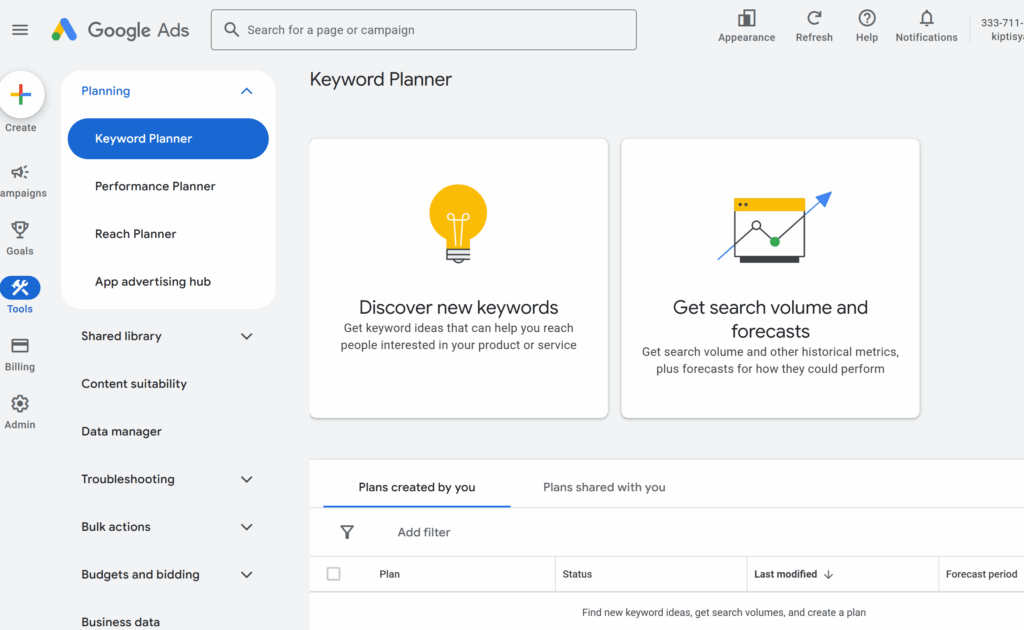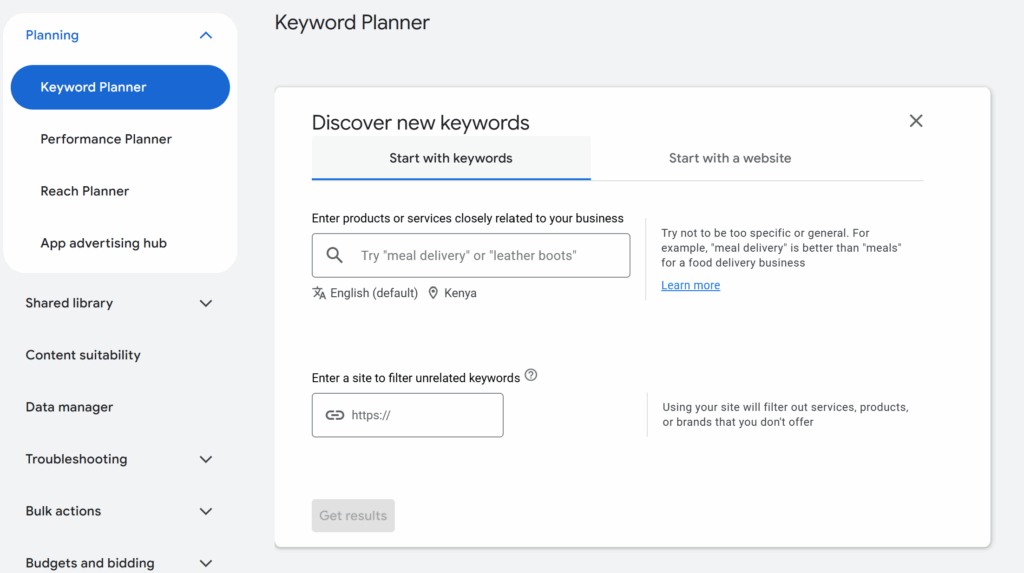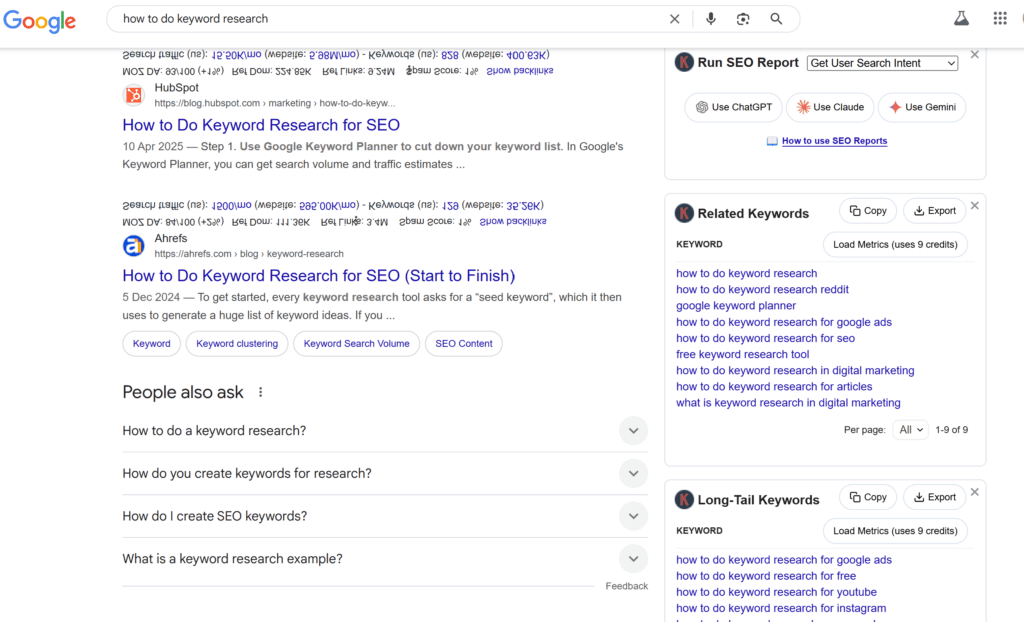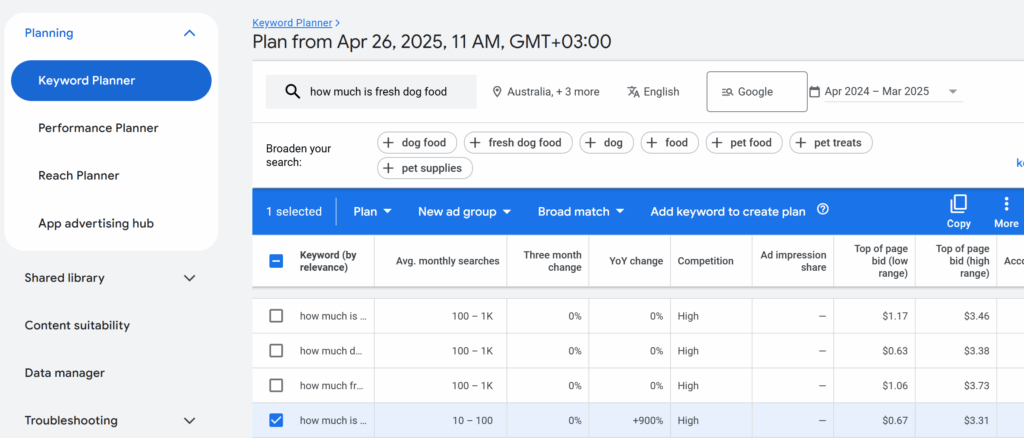Keyword research tools are programs that show you exactly what words and phrases people type into Google when they’re hunting for what you offer.
The best SEO tools for keyword research are the backbone of SEO because they let you peek over your audience’s shoulder and see the kind of content they really want.
There are tons of these tools out there, but the best seo tools for keyword research for you will save you time, give you clear data, and help you actually rank.
When you add those target terms into your articles or pages, you boost your chances of landing on page one of search results.
Believe it or not, keyword research started with pure guesswork back in the ’90s. Fast forward to 2008, and Google rolled out Keyword Planner.
By 2010, SEMrush had its competitor-gap feature. Jump to 2025, and now we’re talking AI-driven topic clusters, live trend tracking, intent analysis powered by natural language processing, and predictive insights.
With all these technological advancements, you don’t want to be stuck with a basic tool that leaves you on page five.
But…there are so many ways to use keyword data, which may leave you stuck.
That’s why I’ll walk you through some of the best seo tools for keyword research, including SEMrush, Google Keyword Planner, Keywords Everywhere, and Google Trends.
You’ll see how each of these best free websites like SEMrush tackle different tasks, so you can combine them to zero in on keywords that bring in real, relevant traffic. Even a term with tons of searches won’t do you much good if it doesn’t match your goals. So let’s get in and learn about the best free seo keyword tools that can help you find top SEO keywords that matter most to your audience.

The Four Must-Have and Best Seo Tools for Keyword Research
- SEMrush
You’ve probably heard that SEMrush is a top-tier keyword research tool for advanced SEO. But does that mean that you can’t use it if you are just a beginner? Not really.
You don’t need to be an SEO wizard to use this best tool for keywords research to find top SEO keywords. The interface can look daunting at first, but stick with me: In the next section I’ll show you a simple method to pair SEMrush with some simpler and best free seo keyword tools so you’re never lost in the data.
What really sold me on SEMrush as one of the best SEO tools for keyword research is its deep, granular data. In one place, you can see everything from search volumes and keyword difficulty to competitor gaps.
Even on the free plan, you get up to 10 analytics reports a day and can track 10 keywords which is more than enough to start uncovering low-competition gems your competitors are missing.
Free tools like SEMrush free plan comes with a TON of keyword data. You can see which SERP features a keyword triggers (think featured snippets, image packs, site links—you name it), content-driven keyword suggestions, and spot exactly where competitors are dominating keywords you’ve overlooked.
Another good thing about SEMrush is that you don’t have to know code or technical SEO jargon.
SEMrush just rolled out Copilot AI, which proactively flags situations like sudden ranking drops and gives you alerts instead of having to hunt through dashboards.
On the free plan you’ll explore tools like:
- Keyword Overview: All the basics you need to find top SEO keywords, including volume, difficulty, related questions, search intent.
- Keyword Magic Tool: Perfect for brainstorming new angles.
- Keyword Manager & Position Tracking: Keep an eye on the exact phrases that matter.
- Competitive Keyword Gap: Find top SEO keywords where your competitors are ranking and you’re not.
- Organic Traffic Insights: You can link this tool to your Google Analytics or Search Console to finally see those “not provided” terms.
Now you need to understand that upgrading to a paid plan is what will get you some of its exclusive features such as domain overviews and larger report limits. The paid plan can feel steep if you are just starting out (starting at $129.95/month)
But here’s my promise: If you want to find keywords free of charge, I’ll walk you through using SEMrush’s free tier alongside other best seo tools for keyword research such as Google Trends and Keywords Everywhere so you can find top SEO keywords for your niche.
- Google Keyword Planner – Still Useful in 2025?
Google Keyword Planner remains one of the best free SEO keyword tools available, especially if you’re looking for solid data straight from the source.

You can use it even if you never run a Google Ads campaign. Pair it with free tools like SEMrush free plan and you will uncover keywords with reasonable search volumes, low competition, but high traffic potential.
If you do choose to advertise, you’ll also get access to forecasting and budget-planning features, which is useful for mapping out your ad spend.
If you’re running ads, the “Forecast” section gives you an estimate of how different budgets and bids might perform, so you can plan ahead.
And even if you’re focused on organic SEO, this top free keyword research tool can highlight opportunities where ranking naturally could reduce your need to spend on paid clicks.
There are two ways to use keyword research Google Keyword planner: “start with keywords” and “start with a website”

1. Using the Keywords Method
Under the “Keyword ideas” tab, you enter a seed term or your website URL and receive a list of related keywords, along with details like monthly search volume, trend data, competition levels, and bid ranges. You can filter0 results by brand or non‑brand terms, source site, and more.
2. Using “Start with a Website Feature”
This best seo keyword generator method allows you to go beyond what your competitors already know. You simply enter your competitor’s URL and Google will analyze the page’s content and suggest keyword ideas. This can help you find opportunities others might be overlooking, like when using free tools like SEMrush.
Google Keyword Planner doesn’t have all the bells and whistles of paid platforms, but as one of the best free SEO keyword tools, it uncovers best keywords competitors miss out on and foundational data you can build your SEO strategy around.
- Keywords Everywhere
Keywords Everywhere is one of the best free SEO keyword tools for quick, on-the-go insights.
It is a lightweight browser extension (available for Chrome, Firefox, and Edge) that shows you keyword data right where you’re searching—whether that’s Google, YouTube, Amazon, Etsy, eBay, or even tools like Google Keyword Planner, Search Console, Analytics, Trends, Ubersuggest, Majestic, Moz Open Site Explorer, AnswerThePublic, Soovle, and more.
As soon as you run a search, this top free keyword research tool drops in related terms and long‑tail ideas, complete with monthly search volume, competition level, and cost‑per‑click data. You get all the info you need in one place without the need to hop between tabs or logging into a separate dashboard.
for example if I search for “how to do keyword research,” you will see keyword data populate on the right side of the Google SERPs

The base version is free and still incredibly useful, just like other free tools like SEMrush free plan. You’ll get keyword suggestions, trending searches, and basic search volume data—enough to fuel early-stage keyword research and work with other best seo tools for keyword research.
If you want to upgrade, the cheapest plan (billed annually) is just $2.25 per month for 100,000 credits, making it one of the most affordable and best tool for keywords research out there.
Personally, I love how it helps me uncover niche keywords I might never have thought to try.
With Keywords Everywhere installed, you can expect to see:
- Search volume right beside every result
- Competition level so you know how hard it’ll be to rank
- CPC estimates for paid campaigns
- Related keywords and long‑tail suggestions instantly
- Integration across dozens of platforms without extra logins
This best free keyword generator is a simple, convenient way to get keyword insights while you perform searches with no extra dashboards, and no guesswork.
Even if you don’t upgrade, Keywords Everywhere stands strong among the best free SEO keyword tools because it gives you instant access to insights without slowing you down or forcing you to toggle between tabs.
Pair it with free sites like SEMrush, including Google Keyword Planner or Google Trends, and you’ll build a well-rounded keyword strategy that’s both fast and accurate.
- Google Trends – A Secret Weapon for Intent and Timing
Google Trends is another best seo tools for keyword research for seeing how people’s interest in a keyword changes over time and across different places and languages.
Here’s how to make this best free keyword generator work for your keyword research:
Set Your Region
The first thing is to pick the geography that matters to your audience. Whether it’s a country, state, or city, Google Trends adapts its charts to show exactly how your keyword’s popularity changes in that area.
Start Your Search
Pop your seed term into the search bar and hit “Explore.” You’ll see a graph with scores from 0 to 100. A score of 100 shows that the level of popularity of your keyword is at peak interest, while 0 means it’s getting the least amount of search interest it ever has. Spotting the highs and lows helps you pinpoint seasonal trends so you can schedule your content when interest is hottest or starting to rise.
Filter for Precision
If you want to get more specific data and narrow things down, use the time range, category, and geography filters at the top. Tweak them until you’ve zeroed in on exactly the data you need.
Explore Deeper Insights
As you scroll down further you will find more useful keyword data including:
- Interest by City: This section breaks down how much a keyword is being searched in different regions or cities. You can quickly spot which states or districts show the highest interest in your term.
- Related Topics: See what other topics people who search your keyword are curious about, which is great for brainstorming complementary content.
- Related Queries: Discover the exact phrases or questions people pair with your keyword. These can spark new article ideas or FAQs.
Compare Keywords
Google trends allows you to compare the changing interest of different keywords in your niche, so you can choose those that are leading in terms of popularity. To do so, click “Compare” and add a second term (or more). You’ll get side-by-side graphs to see which keywords are more popular and when.
One thing to keep in mind is that Google Trends won’t give you actual search volumes or show how tough a keyword is to rank for. That’s where the other best seo tools for keyword research like SEMrush comes in—to estimate how much traffic you might get and how competitive each term is.
While it doesn’t give you search volume numbers like some other tools, that’s actually its strength. You can use it to validate whether a keyword is growing or dying out—making it the perfect complement to other best free SEO keyword tools like Google Keyword Planner and Keywords Everywhere.
That is why in the next step, I’ll walk you through a step-by-step strategy that combines all these tools—Google Trends, SEMrush, and the others to uncover true keyword goldmines for your niche.

The Step-By-Step Keyword Strategy That Combines The Best SEO Tools for Keyword Research
Remember how I promised to walk you through a foolproof way to sharpen your keyword research—without breaking the bank on a SEMrush subscription? Well, here it is.
This approach works because it combines the best seo tools for keyword research to find top SEO keywords that actually drive clicks and conversions, instead of obsessing over huge search volumes or high keyword difficulty scores that your new site simply can’t handle.
If your site is just getting started, has low authority, or lives in a super‑competitive niche, you’ll love this trick: hunting down the long‑tail gems that the big players haven’t dedicated full pages to yet.
Those extra‑specific phrases may have smaller search numbers, but they’re your best shot at ranking quickly.
Before you begin your search, install the Keywords Everywhere extension if you haven’t already—one of the best free SEO keyword tools out there for surfacing keyword data right inside your browser.
Step One: Start by Google Itself
Before you get into free websites like SEMrush, get straight into the source—Google, Bing, or YouTube’s autocomplete.
Start typing your main keyword with different modifiers up front (“best dog food,” “how dog food,” “why dog food,” etc.) and watch what suggestions pop up. Those little drop‑down prompts are real queries people are using right now. Play around with modifiers like “quality,” “when,” or “what,” too because each one gives you fresh insight into how your audience actually searches.
Here is how Youtube Autocomplete goes like when you search for “how dog food”:

Those autofill results are pure gold—they’re the exact phrases people are typing when they want answers. Note down any unique keywords.
Step Two: Use the Keywords Everywhere Extension
As you type your main keywords into Google or other sources, keep an eye on the sidebar. All this time, Keywords Everywhere will be giving you extra keyword ideas on your right side of Google results. Jot down every unique suggestion you see; you never know which little phrase will turn into a traffic magnet.
Step Three: Vet Your List in SEMrush
Once you’ve got your list, plug those keywords into free websites like SEMrush free plan. Focus on keywords that show low and even “zero search volume.”
These are the niche phrases that the major players ignore, but they can still bring in targeted traffic and help you rank faster.
SEMrush gives you deep insight into search intent, competitor usage, and SERP features—but remember, you can use it alongside the best free SEO keyword tools like Google Trends and Keyword Planner to cross-check your findings without going all in on the premium plan.
Step Four: Put Them Through Google Keyword Planner to Confirm Search Potential
Now that you’ve uncovered those unique phrases, it’s time to see which ones really have a search potential. Export your shortlist into Google Keyword Planner (another free websites like SEMrush) and scan for two things:
- Search Volume: Look for terms that pull in around 10–100 searches per month (or higher).
- Growing Interest: Keep an eye on the year-over-year trend—anything that’s climbing means more potential clicks down the road.
For example if you have a keyword “how much is freshpet” that showed quite a low volume in SEMrush:

But in Keyword Planner, you might discover it actually gets reasonable searches a month and has been steadily increasing over the last year(+900).

That tells you it’s a winner worth adding into your content. (Did you see it has a quite low KD but high CPC)
Google Keyword Planner, one of the free websites like SEMrush, helps validate keyword ideas you might have overlooked at first glance.
Step Five: Use Google Trends to Confirm Interest Throughout the Year
In this next step, you want to look up your chosen keywords in Google Trends, another one of the best free seo keyword tools. This lets you see if they get steady interest all year or only light up around certain months.
You want to confirm that there is a real user interest for these keywords.
If you spot a seasonal increase, for example a keyword experiences huge search interest during summer, you can time your posts accordingly.
And while you’re at it, swing by Reddit, X (formerly Twitter), or niche forums to see real conversations around your topics. Are people asking questions? Sharing experiences? That’s your green light.
By the end of this step, your shortlist will be made up of keywords that:
- Have real monthly search volume
- Are trending upward year over year
- Face lighter competition
- Show genuine conversations online
These terms might not boast huge search volumes but because they’re laser‑focused, they’ll attract the right visitors and drive better results.
And that is how to uncover the best keywords by combining the best free seo keyword tools including Google Keyword Planner, Keywords Everywhere, Google trends, and free tools like SEMrush free plan.
Step Six: Ensure You Cover Searcher Intent Fully
Before you write on these keywords, you also want to identify the “entities” (people, places, things, features, brands, concepts) that real users associate with those keywords, so your content feels complete and authoritative.
Here’s a breakdown:
- Check for Related Queries (“Bubbles”)
Google your target keyword (the ones you collected from above). Google often shows little clickable bubbles (or a “People also ask” box, or related searches at the bottom).
Those bubbles represent phrases that other searchers commonly use alongside your main keyword.
- Click Each Bubble → Collect Entities
Click one bubble to rerun the search for that related phrase. On this new results page, scan the titles, snippets, headings, Product/Brand mentions, model names, features—anything that looks like an important term or “entity.”
Write those down for example: if your target keyword is “wireless earbuds,” you might see “noise cancellation,” “Bluetooth 5.2,” “IPX4 water resistance,” “Sony WF-1000XM4,” etc.
- Repeat & Compile
Go back and click another bubble, repeat the process. By the end you’ll have a list of all the frequent terms/entities people connect to your core keyword.
- Group & Theme
Organize similar items into groups. E.g. all the battery-related terms in one group, all brand/model names in another.
This grouping shows you the main “themes” Google—and users—expect to see covered when writing about your keyword.
- Leverage “People Also Ask” (PAA)
In Google results you’ll often see a “People also ask” section—those are actual questions people type that relate to your keyword. Write down those questions (e.g. “How long do wireless earbuds last?” “What is IPX4?”) and make sure your content answers them naturally.
Why do this?
- Covers User Intent Fully: You’re not just sprinkling your main keyword around; you’re showing you understand all the facets (entities) people care about.
- Boosts Relevance Signals: Search engines recognize that your page mentions the same brands, features, and concepts they see in their own data—so they’re more likely to rank you.
- Creates Better, Richer Content: You avoid missing crucial sub-topics that users expect, and you answer their questions directly.
So, in short, after you find top seo keywords using the best seo tools for keyword research, manually explore Google’s related-search suggestions and “People also ask” to harvest the actual terms and questions people use. Then weave those entities/themes/answers into your article so it hits every angle of what your readers—and Google—want.
Find The Best SEO Tools for Keyword Research in Your Niche
And that is your roadmap to uncovering the right keywords for your niche using the best free seo keyword tools. Use these steps to move beyond guesswork and start targeting terms that actually bring in the right kind of targeted traffic to your site.
If you are stuck in any step of your keyword research process please feel free to text me. I enjoy helping small businesses and startups discover hidden keyword gems that help them rank on search.
Here is my final tip: if you’ve got Google Search Console set up, peek at the keywords you’re already ranking up for—but not quite ranking on page one. Those are low-hanging fruit. Since Google already thinks your content is relevant (you’re getting impressions and clicks!), a little tweak can help you turn those into quick wins.
One last pro tip: Happy optimizing!